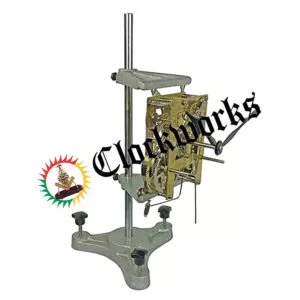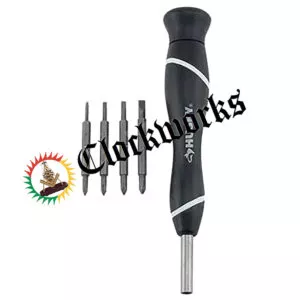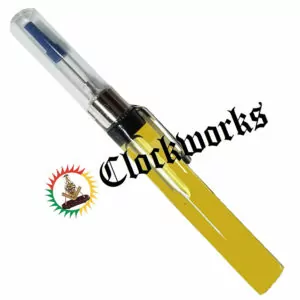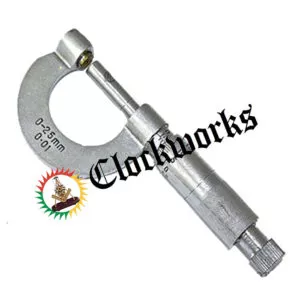Please view these information tabs to help get Clock Loop-End Mainspring Replacements
Loop-End Clock Mainspring Description
The Loop-End clock mainspring description consists of a long flat spring with a loop on one end. This loop wraps around the outer plate pillar of the movement. In other words, this is the type of mainspring that can be seen.
Thus, it is not inside a barrel. Likewise, if the spring is in a barrel, the mainspring can't be seen. Hence, a mainspring that cannot be seen is a hole end mainspring. So, hole end mainsprings can be found on the hole end mainspring page.
Specifically follow the directions to match up your spring to a new one. Should you need assistance please feel free to email us questions. Of course, our experienced clockmakers are happy to help.
How to know if it is broken
Use the clock key to wind the mainspring. Naturally, the spring is broken when it winds for a bit and then snaps back.
Certainly, it could be wound forever and it will not stay in a coil. This is how a spring reacts when it breaks. When the spring breaks, it can protrude a great deal outside of the movement.
On the other hand, if it is a hole end mainspring it will usually stay within the barrel. In extreme cases, the mainspring will damage the clock case. Of course, this is not a common occurrence, but it can happen. Consequently, we do not repair cases.
In fact, that would need a woodworker to fix. Above all, mainsprings can be very dangerous when they snap. Also, it is possible for mainsprings to cause damage to the gears in the movement. Naturally, if this happens then a restoration needs to happen. Please email us for more information on this topic.
How Loop-End Clock Mainsprings come
These mainsprings come wound up with a tie wire around it. Once the movement is put back together, make sure it is wound up all the way and cut the tie wire. As mentioned previously, treat mainsprings with respect and caution.
Always wear safety glasses and gloves. Seriously, mainsprings are nothing to fool with. They can punch, whack, cut, and snap at you. All things said, mainsprings are quite possibly the only dangerous part to work on in a clock.
Repair service
clockworks.com offers a clock repair service. For a loop-end clock mainspring, it would be a movement restoration instead of a mainspring swap.
This might be the best solution. Since mainsprings can cause a great deal of damage when they break. There could be much more damage than just a broken mainspring. A restoration will take care of any damage that may occur from the break.
If you choose to go this route please email a picture of the movement. Of course, we will get back to you on the best solution. A picture is always a good start so we know exactly what you have. Once we see the movement, we can provide a quote to restore it.
If the mainsprings are breaking then it is quite possible that the movement is in need of other work. This is typical of anything mechanical. Once one thing breaks, usually other parts are not far behind.
Clockworks will advise what is the best and least expensive way to get the clock back up and running. Clockworks always has your best interest at heart. Occasionally movements are beyond repair. This does not happen often, however.
Clock Mainspring Break - Damage Assessment
When a mainspring breaks within a clock movement, it could cause damage. This damage could be within the movement itself or to the clock case. However, it is uncommon, but sometimes even the sides of the wood case can sustain damage when a mainspring breaks.
The German movement
As for the movement itself, we need to check the gear teeth and the gear arbors. Any damage will be on the lower part of the gear train if anywhere. Initially, the teeth of the gear that the mainspring is on, is a good place to start.
The next gear up is also a frequent damage area. As you go up the gear train, to the smaller wheels, damage is unlikely. So the force of the breaking impact happens in the lower wheels, typically the main wheel and the next one up.
Antiques with lantern pinions
Lantern pinions are the type of gear that is made of vertical wires instead of teeth. So it would be the smaller side of the two intersecting gears and would be going up the train not down. Thus the vertical wires within the circular brass bushings act as teeth instead of having a gear.
Subsequently, the advantage is the wire will spin within the bushings and decreasing friction and wear. However, not all clocks have lantern pinions, this would apply to some antique American time strike units only.
Lantern pinion damage check
If the clock has lantern pinions it is possible that some pins have bent or broken off completely. It would happen on the next wheel up from the mainspring gear, or main wheel.
Therefore, the impact of the main wheel from the break jolts the next wheel up with such force the pinion cant withstand the impact often. These are not so easy to repair if the pin breaks, it requires the removal of the pinion and the dismantling of the pinion to restore it.
So the gear or wheel, comes out, remove the pinion via a staking set. Repair this with the same steel rod size to make it perfect again. If the pin is just bent sometimes you can straighten it again with needle nose pliers for a quick fix.
Checking arbors and pivots
Meanwhile, assess the damage to the arbor of the next wheel up from the main wheel. Often it will be bent from the impact of the mainspring breaking and you would need to straighten it again if possible.
Furthermore, it is best to remove it and roll the arbor's long side on the table and see if it rolls straight.
Also, and just as important, check the skinny ends of the arbor known as the pivots. These are the skinny ends of the arbor that stick into the movements outer main brass plates.
If these are bent, the clock will not run. They need to be straight or the clock will have too much resistance in the gear train for the clock to function under the power of the new mainspring.
The teeth of the gear wheels
Lastly, inspect the teeth of the gears on both the main wheel where the spring was, and the next wheel up. Ordinarily, bent teeth are common but not as easy to correct.
Otherwise, bending back and reshaping them with a needle file sometimes works, other times the wheel needs a chunk cut out and you replace it by soldering new teeth in place.
Wooden clock case inspection
At any rate, make sure to get the movement out with no further damage to the clock case. Then check the condition of the case to be sure it does not need attention. It may need glue or nails to make it more secure as the impact of the spring breaking could loosen the boards.
To much information
On the other hand, if this is not in the realm of interest in learning about and experimenting with, please send us the movement instead. We will take care of everything for a fee. Please email a pic of what is going on to [email protected] so we can quote.
Clock Loop-End Mainspring Measuring
Measure Loop end mainsprings by width, thickness, and length. These are not always easy measurements to get, and the mainspring would need to be taken out from the clock.
It can be a frustrating puzzle to do, and a dangerous one also. But if learning clock repair or have time on the hands so to speak, here are some guidelines.
Caution !!
Always wear gloves and safety glasses when working with mainsprings. They can cut or punch the person working on the clock so please treat them with respect. It is not uncommon for the mainspring to break or shatter while working with them.
Just treat them with caution and respect while protect the hands and eyes. Be aware if a mainspring is wound up or when you stretch it way out to measure it, it has a lot of snapping power. These things can hurt when they smack the hand or fingers, or eye.
Getting the thickness and width
The items you need for this measurement are a tape measurer and a digital caliper, these are the best things to use. To get the width of the mainspring is easy, just use the digital caliper in inches and see how wide it is first.
Look on the chart below for the width column. Next is the thickness, again using the digital caliper in inch or mm. Write these two measurements down and again refer to the chart and narrow down the section even more. Now have a narrow section of the chart of sizes working with and only need the length.
Measuring the loop-end mainspring length
The length is the hardest to get the measurement on. What we do here is put the end of the spring in a vise and stretch it out. We pull the spring straight with a tape measure beside it as we unwind it.
Of course the tension of the spring is such it wants to wind back up in a violent manner.
When the spring is let go it winds back up with a snap. If there is a cat sitting by the vise and let go, the cat may not like you anymore. The length is the hardest to get but close enough is ok.
The length has not much to do with the function of the clock, only the time in which the clock will run. For example if the mainspring substantially shorter, it may not run the full 8 days.
Alternate way of measuring the length
It is possible to make the mainspring straight by just putting bends into the spring to uncoil it. Start from the end and every 6 inches put a bend with pliers in the opposite direction of the coil to make it straight.
The mainspring will eventually all be straight and then you can measure the length.
The most common size loop end mainspring for antique 1900s through 1945 American units is CML304. This size was sort of the industry standard when Seth Thomas, New Haven, Gilbert, Sessions was in full swing with the 8 day time strike units in mass production.
Loop End Clock Mainspring
To begin with, initially measure the width and align it with the width below. Subsequently, employ a micrometer to measure the thickness. Consequently, the resulting measurement will serve as an approximate length. Lastly, peruse the order list of options and select the item number corresponding to the desired mainspring, followed by clicking the "add to cart" button.
Measurements to Item #
| WIDTH inch | mm | THICKNESS inch | mm | LENGTH inch | Item # |
|---|---|---|---|
| 1/8' 3.2 | .010' | 0.25 | 19' | CML 245 |
| 9/64' 3.6 | .009' | 0.23 | 25' | CML 246 |
| 5/32' 4 | .009' | 0.23 | 26' | CML 247 |
| 3/16' 4.8 | .012' 0.3 | 31' | CML 252 |
| 3/16' 4.8 | .016' 0.41 | 54' | CML 253 |
| 13/64' 5 | .0105' 0.26 | 25 1/2' | CML 254 |
| 7/32 5.6 | .011' 0.28 | 24' | CML 255 |
| 7/32 5.6 | .017' 0.43 | 30' | CML 256 |
| 1/4' 6.4 | .010' 0.25 | 26' | CML 257 |
| 1/4' 6.4 | .012' 0.31 | 41' | CML 259 |
| 1/4' 6.4 | .013' | 0.33 | 24' | CML 260 |
| 1/4' 6.4 | .016' | 0.41 | 54' | CML 261 |
| 9/32' 7 | .009' | 0.23 | 30' | CML 262 |
| 9/32' 7 | .012' | 0.3 | 27' | CML 263 |
| 9/32' 7 | .012' | 0.3 | 30' | CML 264 |
| 9/32' 7 | .017' 0.43 | 48' | CML 265 |
| 19/64' 7.5 | .015' 0.38 | 39' | CML 266 |
| 5/16' 8 | .009' 0.23 | 20' | CML 267 |
| 5/16' 8 | .009' 0.23 | 36' | CML 268 |
| 5/16 8 | .010' 0.25 | 30' | CML 269 |
| 5/16 8 | .013' 0.33 | 24' | CML 270 |
| 5/16' 8 | .013' 0.33 | 30' | CML 272 |
| 5/16' | .013' 0.33 | 30' | CML 272 |
| 5/16' 8 | .015' 0.38 | 42' | CML 273 |
| 5/16' 8 | .016' | 0.41 | 54' | CML 274 |
| 5/16' 8 | .016' | 0.41 | 72' | CML 275 |
| 5/16' 8 | .017' | 0.43 | 42' | CML 276 |
| 5/16' 8 | .020' | 0.51 | 46' | CML 277 |
| 3/8' 9.5 | .011' 0.28 | 51' | CML 279 |
| 3/8' 9.5 | .013' 0.33 | 34' | CML 280 |
| 3/8' 9.5 | .014' 0.36 | 48' | CML 281 |
| 3/8' 9.5 | .014' 0.36 | 60' | CML 282 |
| 3/8 9.5 | .015' 0.38 | 53' | CML 283 |
| 3/8 9.5 | .016' 0.41 | 60' | CML 284 |
| 3/8' 9.5 | .017' 0.43 | 96' | CML 285 |
| 3/8' 9.5 | .019' 0.48 | 48' | CML 286 |
| 7/16' 11 | .014' 0.36 | 72' | CML 287 |
| 7/16' 11 | .018' | 0.46 | 48' | CML 288 |
| 7/16' 11 | .018' | 0.46 | 60' | CML 289 |
| 1/2' 12.7 | .015' | 0.38 | 84' | CML 290 |
| 1/2' 12.7 | .016' | 0.41 | 66' | CML 291 |
| 1/2' 12.7 | .018' | 0.46 | 60' | CML 292 |
| 1/2' 12.7 | .018' 0.46 | 96' | CML 293 |
| 6/16' 14.3 | .015' 0.38 | 78' | CML 294 |
| 9/16' 14.3 | .018' 0.46 | 96' | CML 295 |
| 5/8' 16 | .013' 0.33 | 69' | CML 296 |
| 5/8 16 | .018' 0.46 | 96' | CML 297 |
| 11/16 17.5 | .015' 0.38 | 108' | CML 298 |
| 11/16' 17.5 | .018' 0.46 | 96' | CML 299 |
| 3/4' 19 | .012' 0.31 | 72' | CML 300 |
| 3/4' 19 | .014' 0.36 | 108' | CML 301 |
| 3/4' 19 | .016' | 0.41 | 78' | CML 302 |
| 3/4' 19 | .017' | 0.43 | 120' | CML 303 |
| 3/4' 19 | .018' | 0.56 | 96' | CML 304 |
| 13/16' 20.6 | .018' | 0.46 | 96' | CML 305 |
| 7/8' 22.2 | .018' 0.46 | 96' | CML 306 |
| 1' 25.4 | .018' 0.46 | 96' | CML 307 |

















Hi
My loop mainspring measure 3/8 x 0.4. x 49”
Should I buy the CML 281 or 283
There appears to be enough room on the winder
Thanks
If there is enough room, so be it and that is the way to go
James Stoudenmire
40yr Clockmaker
Author of Clockworks.com
Morning, How do I know which one I need for a Hapeanker Wesminster clock?
Thans, Steve
Would need to be measured.
Or send the clock in for service, either way
James Stoudenmire
30yr Clockmaker
Author of Clockworks.com
Hello
Im looking for the size of a seth thomas number 40 movement main springs its time only
Need to measure that one, or just send it in for us to service the movement.
Sending in?
James Stoudenmire
30yr Clockmaker
Author of Clockworks.com
I have a 1960s alarm clock called Renown Repeat Alarm made in West Germany. I think the springs maybe the alarm springs but definitely the main clock spring need replacing.
What type of springs should I order? Thank you!
Would need to remove the old one and measure the length / width / thickness
James Stoudenmire
30yr Clockmaker
Author of Clockworks.com
My original spring is a loop end 3/4″ x .12 x 106, you 301 spring is out of stock. Do you expect more soon? Do you have a recommendation of a different spring that is in stock and would be functional?
Please check back in 2 weeks
James Stoudenmire
30yr Clockmaker
Author of Clockworks.com
I don’t see a measurement for diameter of the middle hole of the spring. Mine is approximately 1/8″. How do I know which spring to order.
It is malleable and variable, dependent on what it is bent too. Needle nose for a tight fit, closing the center hole as to ensure a grip on the center nub of the arbor
James Stoudenmire
30yr Clockmaker
Author of Clockworks.com
Could You help me with a Loop End Mainspring which length is 55′ 3/4” and the width is 21/32” , and the thickness is approx.. 0.5 mm. I don’t see these measurements in Your list, so I wonder if you can help with one i can use. Thanking You in advance I remain, AR Carrion. Rocky.
We have to offer only what is on the list
James Stoudenmire
30yr Clockmaker
Author of Clockworks.com
Hello James.
I need to know the Diameter of the 1 inch wide .018 thick loop end spring.
Strange question for a loop end spring. Diameter varies depending on how much it is wound up.
James Stoudenmire
30yr Clockmaker
Author of Clockworks.com
Hello James,
I am in need of a 7mm x .43 x 30″ open loop mainspring for a vintage alarm clock. As this is unavailable, would I be better off with a 7mm x .43 x 48″, a 7mm x .30 x 27″ or possibly a 5.6mm x .43 x 30″?
Thank you
Tough call. I suppose I would grab the 7mm x .30 x 27″ but none are ideal.
James Stoudenmire
30yr Clockmaker
Author of Clockworks.com
I’m needing a loophole spring 108” long 3/4 wide.20 or thick this would been the striker side
What is on the list is what we have to offer
James Stoudenmire
30yr Clockmaker
Author of Clockworks.com
Good day Sirs, I’m in need of a Loop End Clock Mainspring and the measurements are: Length is +- 55 3/4 inches which is about 141.5 cm, the width is 5/8 inch or 21/32″inch, nd the thickness is about .3mm. To me the CLM 296 is compatible with the measurements I gave. please let Me know if it is so, s I can order one.
Thanking You in advance. I remain: Anthony R Carrion.
We have only to offer what is listed
James Stoudenmire
30yr Clockmaker
Author of Clockworks.com
When ordering the mainspring and the length doesn’t match that of the one I’m replacing, do I order the longer or shorter replacement?
I’m looking at CML288 which is 48 inches. The spring from the clock is between 52-53 inches.
In theory the longer the mainspring the more run time. However we need to consider if there is enough room in the barrel for this or not. If the spring is shorter it will maybe only run for 7 1/2 days instead of 8
James Stoudenmire
30yr Clockmaker
Author of Clockworks.com
Can just a broken sprocket that handles a pull up chain on a Zanies (miss spelled) clock be purhased?
Looking for a repair person in the Richmond/ Williamsburg VA area!
Sorry do not have the part, but may have the movement complete brand new if it comes down to it. Just need the movement numbers off of the back plate of that one please
James
Dear Sirs, i have a Zenith savings clock in a wooden case that on the back plate in brass has Medor patent stamped. The main spring is broken, which size do I need?
OR
Hole End Mainspring replacement service
We can do the task of measuring and installing the mainspring if you choose to send it in. Read More »
If going with the mainspring replacement because the clock is still in good shape or out of production new, then if you choose to send the entire barrel with the mainspring in it, we can swap it out for $30.
We will take out the mainspring and measure the width / thickness and approximate length and then install the correct spring back into the barrel.
If doing this please send to Clockworks PO Box 339 Huntington MA 01050 with your contact information.
It may be best also to send us an email to clockworks@clockworks.com so we can look out for the package.
It will end up being the 30 charge, and then add the price of the mainspring as stated in the below chart, and then shipping back to you.
If you would like to send in your barrel with the broken mainspring, please fill out the form at this link so we know its coming into us.
Hi
In order to swap a mainspring you would need to measure the approximate length, the thickness and the width of the mainspring you now have.
You would also need to determine if the clock has a hole end mainspring or a loop end mainspring.
I the mainspring is contained in a casing, called a barrel, then its a hole end mainspring. If you can see the mainspring in the clock then its a loop end mainspring.
Please click the following link and then click the pic of either the hole end or the loop end and you will be brought to a chart for you to find the correct size.
https://clockworks.com/clock-parts/hole-end-mainsprings.html
If all this is too much for you then you can just send the movement / pendulum / hands into us for a repair. However when we do a repair we not only fix the mainspring issue but we test each gear / arbor for damage that often occurs during mainspring breakage. Then we also rebush any worn pivot holes and put the movement through the cleaning and testing process.
I am looking for the mainspring for the pedulum wall clock Ruben Zelnick le Caire